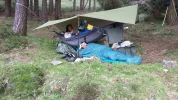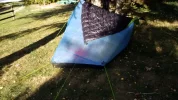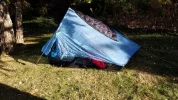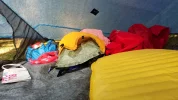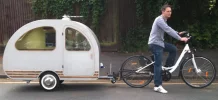For tarp-based shelters, using my trekking poles, I use polycro sheets, which are tough as nails. A full sheet of 96" x 120" weighs about 3.5 ounces, and costs about $12.00 usd. I have a sheet that I've used off and on for 3 years now.
I've attached stick on tapes with rivet openings ($2.50), for locations where I use micro tent pegs ($15.00) and trekking poles, and a length of dyneema-core guyline cord (2.0 mm, $15.00). With pegs, line, permanently attached rivet tapes, and a silnylon stuff sack for it all, it all weighs around 8 ounces. As packed, it takes up no more space than a sport drink bottle.
I do not include the weight of trekking poles or poncho-groundcloth, as I carry those anyway for use in their normal roles.
Because of the existing laws, I would not wild camp in Spain, but utilize available yards and garden spaces at alburgues, hostals, and other permitted sites. That would give me plenty of access to toileting and washing facilities.
I do my backpacking at home. For Camino, I prefer to sleep indoors along the way. Private rooms in alburgues or at casa rurals, hostals, or hotels suit me just fine.

.













